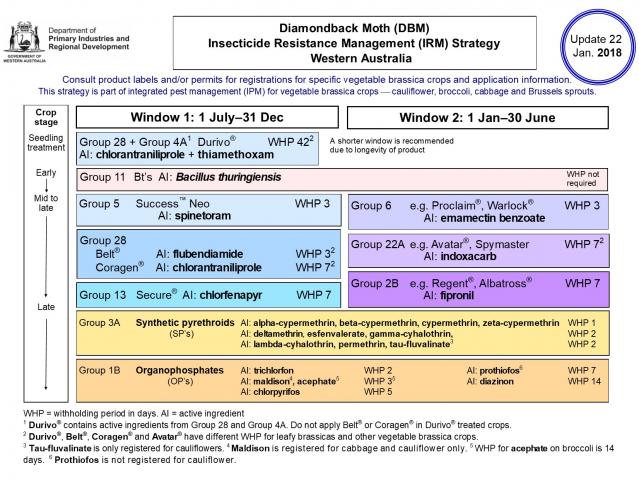Two-window strategy
The two-window strategy should be used as part of an integrated pest management (IPM) program in conjunction with the above guidelines. The strategy was developed by Australian researchers in conjunction with the chemical industry and growers.
The aim is to slow the development of resistance to insecticides that have been commercially available since 1998, or ‘newer’ chemistry.
The strategy highlights the importance of rotating between groups of insecticides, each with different modes of action. Where practical you should endeavour to use insecticides recommended in each of the windows at the correct time of year to ensure adequate rotation.
'Newer' chemistry’ insecticides are placed into two windows which divide the peak Western Australian diamondback moth season into two equal blocks, allowing equal frequency of use of chemicals from both windows.
Due to differences in climate and pest population peaks three strategies have been developed that cover all major Australian vegetable brassica growing areas. The Western Australian strategy is reviewed regularly - the update number and review date can be found in the top right corner. The strategy is specific to Western Australia and is for the vegetable brassica crops cauliflower, broccoli, cabbage and Brussels sprouts.
Window 1 covers the portion of the season 1 July to 31 December. Registered insecticides from groups 5 (spinosad), 28 (chlorantraniliprole and flubendiamide) and 13 (chlorfenapyr) are placed here.
Trade names for common registered products are: group 5 SuccessTM Neo; group 28 Durivo®, Belt® and Coragen®; and group 13 Secure®. Registered products from any of these three groups can be used in this window. Label instructions must be followed.
Window 2 covers the rest of the season - 1 January to 30 June. Registered insecticides from groups 6 (emamectin benzoate), 22A (indoxacarb) and 2B (fipronil) are placed here.
Trade names for common registered products are: group 6 Proclaim®; group 22A Avatar®; and group 2B Regent®. Label instructions must be followed.
If the window recommendations are followed, diamondback moth populations will not be continually exposed to insecticides from the same chemical group for a whole growing season.

Bts are not placed in a window as they are often only used on young crops when good spray coverage can be achieved. Other active ingredients are used in later crop stages.
Older chemistry including the synthetic pyrethroids and organophosphates are not placed in windows. Many diamondback moth populations already have resistance to some older chemistries. There is also evidence from overseas of cross-resistance between certain synthetic pyrethroid, organosphosphate and carbamate insecticides.
Synthetic pyrethroids and organophosphates are broad spectrum chemicals which will also kill beneficial insects. They are not preferred in an integrated pest management (IPM) program.
The group 28 product Durivo® appears first in window 1 rather than with the other group 28 products because it is used only as a seedling treatment. Ideally when using Durivo® with the window strategy it should not be applied in the final weeks of window 1 as it remains active in the plant for many weeks after application. Ceasing use of Durivo® by early December is recommended to reduce exposure of diamondback moths present from January onwards to group 28 insecticides.
Insecticides that appear in the window strategy have different levels of impact on beneficial insects. If you plan to encourage native populations of beneficial insects or release captive-bred beneficial insects you must carefully consider the insecticides to be used. More information on impact on beneficial insects can be found on the Queensland Department of Agriculture and Fisheries (DAF) website.
Refer to the Australian Pesticides and Veterinary Medicines Authority (APVMA) website for information regarding registration and label instructions for diamondback moth insecticides.
